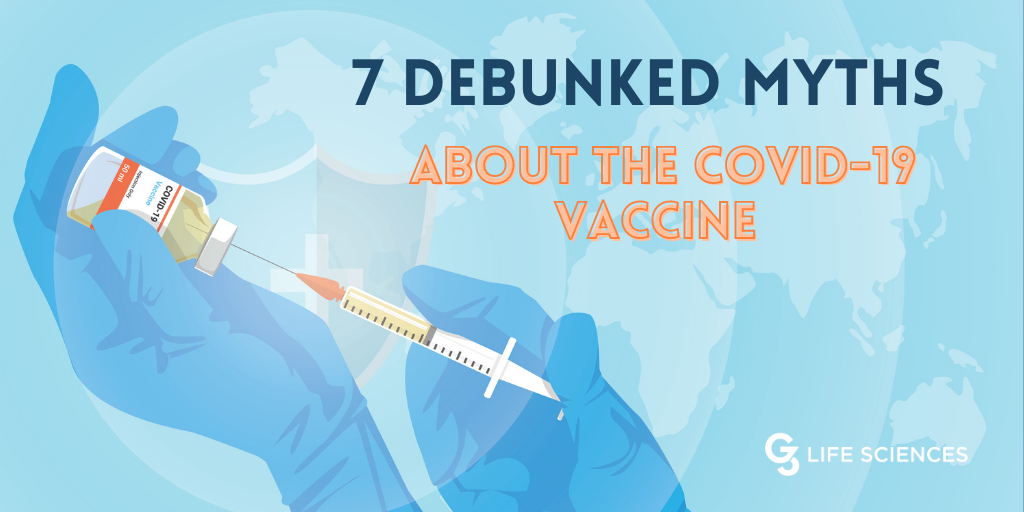Since the beginning of 2019, the COVID-19 vaccine has been one of the most frequently discussed topics in the world.
Some eagerly await and share news of its approval and administration, while others are more trepidatious about accepting the new vaccination.
With so much conflicting information swirling around, understanding exactly how the vaccine works can be confusing. But we’ve done our research and discovered the truth.
Here are seven common myths about the COVID-19 vaccine, debunked:
- Myth: I don’t need to get the vaccine if I’ve already had COVID-19 and recovered.
- Myth: I don’t need to get the vaccine if I’ve already had COVID-19 and recovered.
Truth: It is possible to become infected with COVID-19 even if you’ve already had it before. The cases of reinfection are rare, but they have been reported. From what scientists know of other similar diseases, reinfections are expected, and scientists are currently studying COVID-19 patients to assess how frequently these reinfections occur and how serious they can be.
2. Myth: Once I get the vaccine, I don’t need to wear a mask or follow social distancing safety guidelines.
Truth: Once vaccinated for COVID-19, you should still wear a mask and practice safe distancing. While the vaccine helps prevent you from getting sick, it has not yet been determined if you can still carry and transmit COVID-19 to others. Until more is known about the disease, it is safest to err on the side of caution and protect those around us.
3. Myth: Getting the vaccine will lead to me getting sick with COVID-19.
Truth: None of the approved COVID-19 vaccines will cause you to get sick with COVID-19. Some people may show mild symptoms, such as a fever, but this only indicates that the vaccine is teaching your body how to build up immunity to the disease, so you won’t actually become infected.
4. Myth: mRNA vaccines like the COVID-19 vaccine can alter my DNA.
Truth: mRNA vaccines are “messenger” RNA vaccines, meaning they teach the cells in our bodies how to trigger an immune response. This immune response is what then produces antibodies, which are what help us fight COVID-19 infection. The vaccine never interacts with our actual DNA, and our bodies break down the mRNA after the “message” has been transmitted.
5. Myth: I shouldn’t get the COVID-19 vaccine if I have serious allergies.
Truth: People can be allergic to many different things, but having a serious allergy does not necessarily mean they should not get the vaccine. Only people with allergies to one of the components of the vaccine could have issues receiving it, and you should discuss any serious medical conditions with your doctor beforehand to ensure your safety and proper vaccination.
6. Myth: The side effects of getting the COVID-19 vaccine are worse than the disease itself.
Truth: While some patients may experience side effects after getting the COVID-19 vaccine, they are typically mild and dissipate after a few days. The side effects are a result of your body learning how to build immunity to fight the disease and can include pain or swelling around the injection site, or headache, fever, fatigue, or chills in general. While these symptoms can be uncomfortable for a short time, they do go away and leave your body better protected from COVID-19 than before.
7. Myth: Getting the COVID-19 vaccine can cause autism.
Truth: It has been widely confirmed by scientific communities around the world that there is no link between vaccines and autism spectrum disorder (ASD). This myth originated with a single 1997 British study by Andrew Wakefield that has since been discredited and retracted, and since then countless other studies have proven that vaccinations do not cause autism.
In Context: A History of Mistreatment
It is worth understanding why some people, especially marginalized communities, may be skeptical of government-performed care and vaccinations.
Many Black Americans, for example, have expressed their wariness about receiving the COVID-19 vaccine—a wariness that stems from a long history of American medical institutions abusing or refusing to properly treat Black patients.
An infamous example is the Tuskegee syphilis study in 1932 done by the U.S. Public Health Service, which lasted until 1972. Black men who had contracted syphilis were promised treatment, and instead were studied with the intention of proving that Black people are biologically different than white people, a dangerously racist and false notion. The men received no care for the disease, leading to thousands of others in the Tuskegee Black community being infected, and the entire decades-long incident had a lasting effect on Black Americans’ trust of medical government treatment.
This kind of inequality still exists today in many areas of medical care other than vaccinations. For example:
- Black patients’ reports of pain are not believed as frequently by their doctors as reports of pain from white patients.
- Black mothers are two to three times more likely to die from pregnancy-related causes than white mothers.
It is for these reasons and many more that connecting communities in need with accurate medical information and proper care is so crucial, now more than ever.
Language can be used as a tool to bridge communities, rather than keeping them isolated and misinformed. Contact G3 Life Sciences to learn more about how you can use language to build bridges to those in need.
